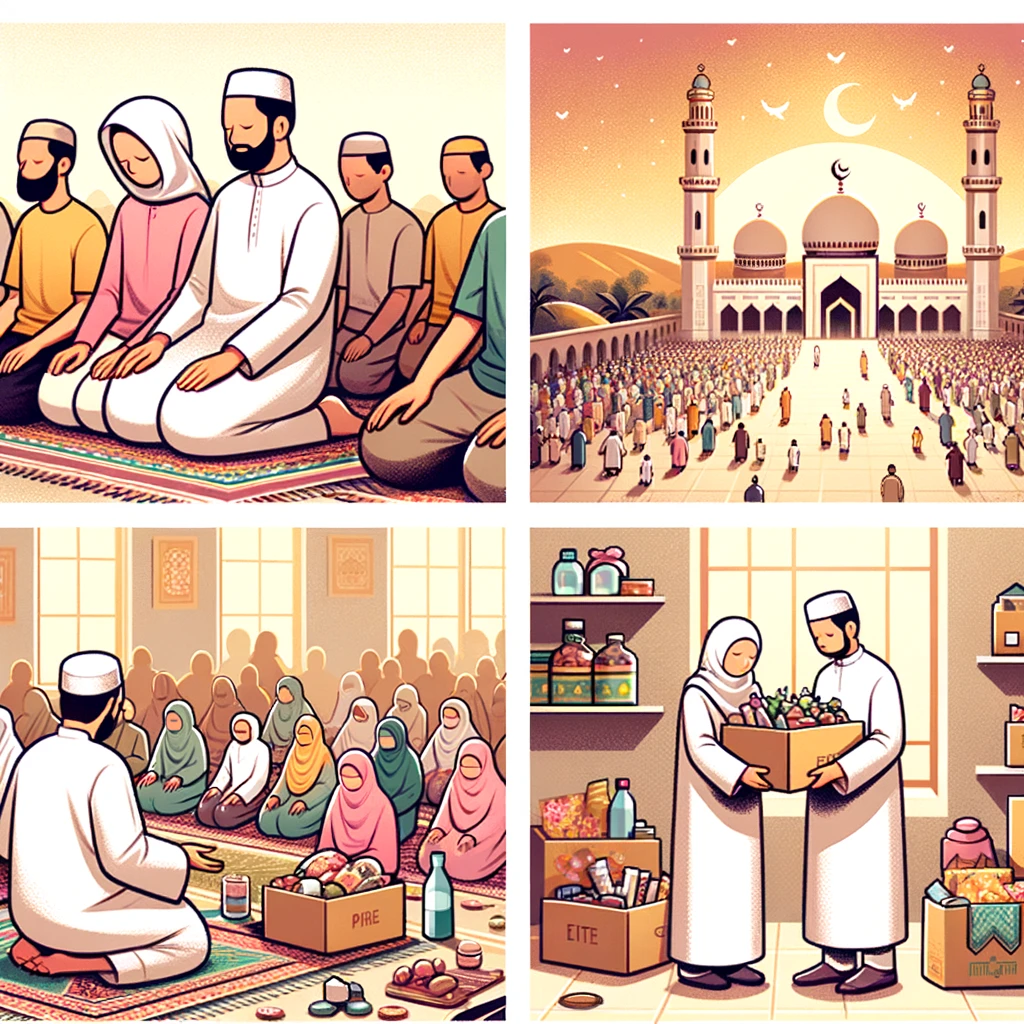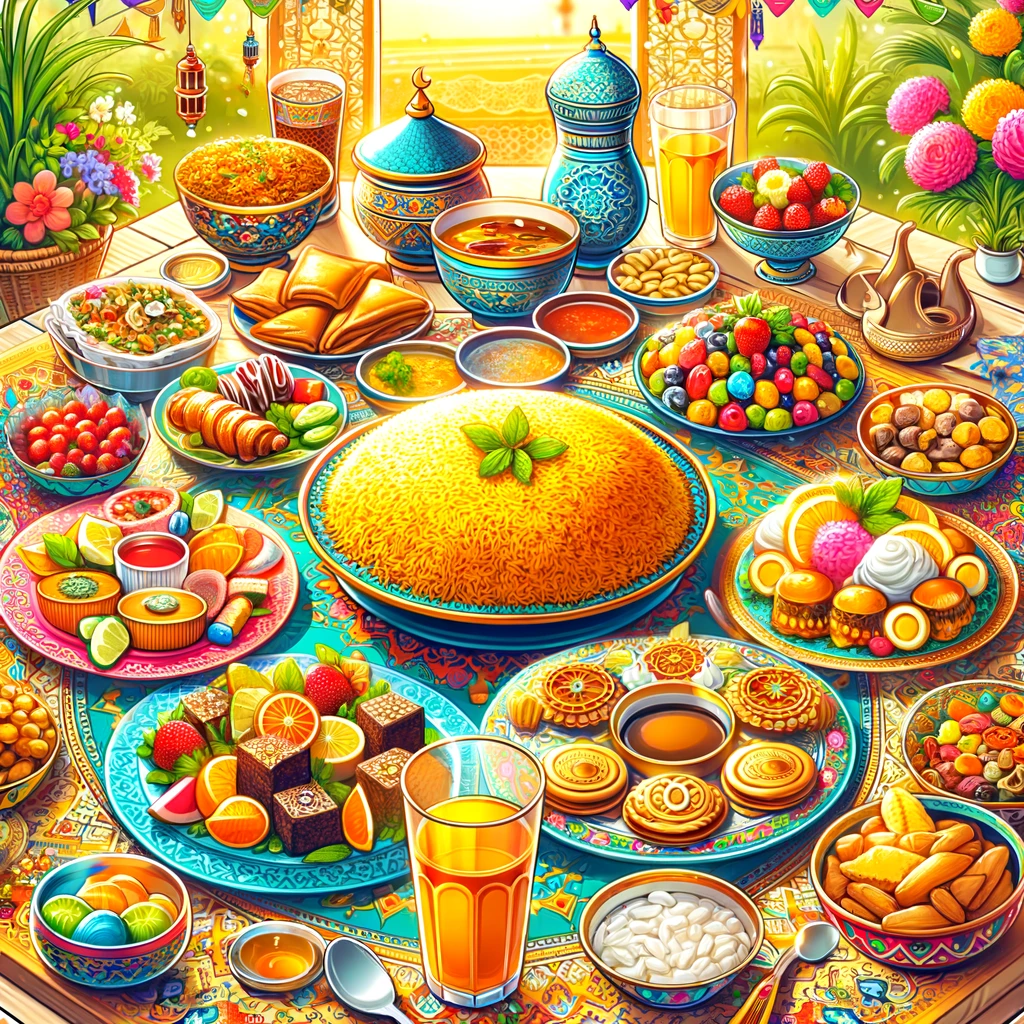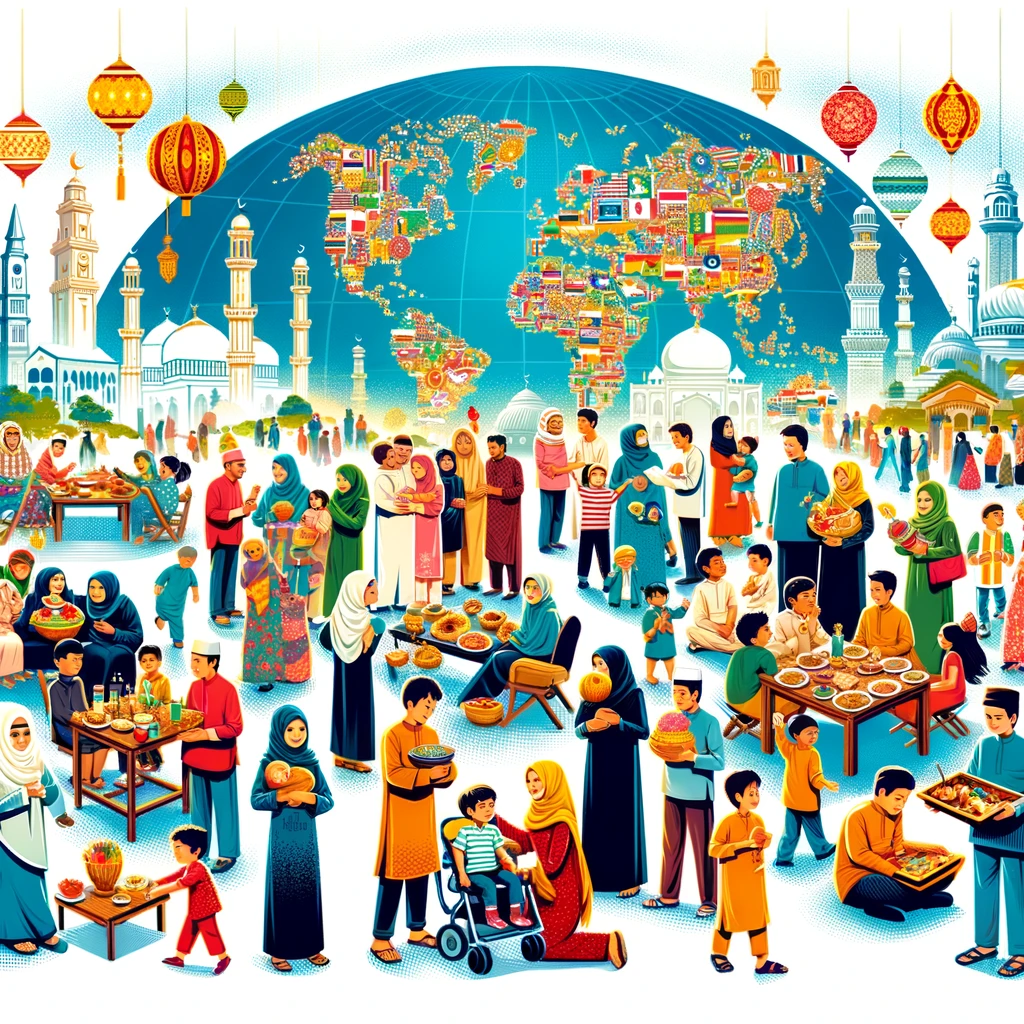Eid ul Fitr: A Comprehensive Guide to Celebrating the Festival of Breaking the Fast

Introduction
- Brief overview of Eid ul Fitr
- The significance of Eid ul Fitr in the Islamic calendar
- Keywords: Eid ul Fitr, celebration, Islamic festival
Understanding Eid ul Fitr
What is Eid ul Fitr?
- Definition and meaning of the festival
- The historical and religious background
- Keywords: Eid ul Fitr, festival of breaking the fast, Islamic history
The Significance of Eid ul Fitr
- Religious significance: Marking the end of Ramadan
- Social and cultural importance
- Keywords: significance, Ramadan, end of fasting
How is Eid ul Fitr Celebrated?
Pre-Eid Preparations
- The night of the moon sighting (Chand Raat)
- Cleaning and decorating homes
- Keywords: Chand Raat, preparations, decorations
Eid ul Fitr Prayers
- The process and timing of Eid prayers
- The importance of communal prayers
- Keywords: Eid ul Fitr prayers, communal prayers, Salat al-Eid
Traditions and Customs
- Wearing new clothes
- Giving charity (Zakat al-Fitr)
- Keywords: traditions, Eid clothing, Zakat al-Fitr
Food and Festivities
- Traditional dishes and sweets
- Family gatherings and feasting
- Keywords: Eid ul Fitr food, traditional dishes, family gatherings
Eid ul Fitr Around the World
- How Eid ul Fitr is celebrated in different countries
- Unique traditions and foods from around the globe
- Keywords: global celebrations, Eid traditions, cultural differences
Modern Celebrations and Innovations
- Virtual Eid celebrations and their rise
- Adapting traditions for the modern world
- Keywords: modern celebrations, virtual Eid, adapting traditions
Conclusion
- Reflecting on the joys and lessons of Eid ul Fitr
- The importance of unity and charity in Eid celebrations
- Encouragement to participate and learn more about Eid ul Fitr
- Keywords: Eid ul Fitr conclusion, unity, charity
FAQs about Eid ul Fitr
What is Eid ul Fitr?
Eid ul Fitr, often referred to as the “Festival of Breaking the Fast,” is one of the most important Islamic holidays. Celebrated on the first day of Shawwal, the tenth month of the Islamic lunar calendar, its date varies each year based on the sighting of the moon. This joyous day is an opportunity for Muslims to give thanks for the strength and patience practiced during Ramadan, a month of fasting, reflection, and prayer.
The origins of Eid ul Fitr trace back to the Prophet Muhammad, who established this day of festivity and gratitude after his migration from Mecca to Medina. It’s a day when the spiritual rewards of the past month are celebrated, and the community comes together in a spirit of joy and brotherhood.
The Significance of Eid ul Fitr
Eid ul Fitr carries profound religious significance for Muslims. It commemorates the completion of Ramadan, a period of fasting, introspection, and prayer. The festival emphasizes the values of charity, family bonds, and community unity. Muslims are encouraged to give generously to the less fortunate, a practice known as Zakat al-Fitr, ensuring that everyone has the means to celebrate the day.
Socially and culturally, Eid ul Fitr fosters a sense of belonging and collective joy. It’s a time when families and friends gather to pray, share meals, and exchange gifts, strengthening communal ties and creating lasting memories.
This introduction sets the stage for a deep dive into the multifaceted celebration of Eid ul Fitr. As we proceed, we’ll explore the traditions, customs, and global variations of this festive day, aiming to enrich your understanding and appreciation of one of Islam’s most cherished holidays.
Learn more about the significance of Eid ul Fitr
Feel free to share your thoughts and experiences in the comments below or through our social media channels. Let’s celebrate the beauty and diversity of Eid ul Fitr together!
How is Eid ul Fitr Celebrated?
The celebrations of Eid ul Fitr are as diverse as the Muslim community itself, but certain traditions and practices are universally observed. Let’s delve into the customs that make Eid ul Fitr a unique and joyous occasion for Muslims around the world.
Pre-Eid Preparations
The anticipation of Eid ul Fitr begins the night before, known as Chand Raat, or the night of the moon sighting. Families eagerly await the announcement of the Eid moon, which signifies the end of Ramadan and the arrival of Eid day. This night is filled with excitement and preparation:
- Shopping and Gifting: Markets and malls are bustling with people buying new clothes and gifts for their loved ones. It’s a tradition to wear new attire on Eid as a symbol of renewal and purity.
- Home Decoration: Homes are cleaned thoroughly and often decorated with lights, lanterns, and ornaments to welcome the festive spirit of Eid.
Eid ul Fitr Prayers

One of the hallmark practices of Eid ul Fitr is the special communal prayer, Salat al-Eid, performed in large gatherings in mosques or open spaces called Eidgahs:
- Timing: The prayer is usually held shortly after sunrise, allowing the community to come together early in the day.
- The Process: Eid prayers consist of two Rakats (units of prayer) with additional Takbirs (saying “Allahu Akbar,” meaning “God is the Greatest”). It’s a time of reflection and gratitude for the blessings received throughout Ramadan.
Traditions and Customs
After the Eid prayers, Muslims engage in various customs that highlight the spirit of community and charity:
- Zakat al-Fitr: Before the Eid prayers, Muslims are obligated to give charity in the form of food or money, ensuring that everyone can partake in the celebration of Eid.
- Feasting and Hospitality: The rest of the day is spent visiting family and friends, sharing meals, and enjoying each other’s company. Special dishes and sweets are prepared and enjoyed together, with popular items like Biryani, Kebabs, and sweet treats like Baklava and Maamoul.
Food and Festivities
Food plays a central role in Eid ul Fitr celebrations, with each culture bringing its own unique flavors to the table:

- Traditional Dishes: In many countries, traditional Eid dishes are prepared, which may include Lamb or Beef dishes, Rice dishes like Biryani or Pilaf, and a variety of sweets and desserts.
- Family Gatherings: Homes open their doors to relatives and friends for festive gatherings, where stories are shared, and laughter fills the air.
Celebrating Eid ul Fitr is about more than just the end of Ramadan; it’s a time for gratitude, giving, and community. The practices surrounding this day reflect the diverse yet unified spirit of the Muslim community worldwide.
Check out traditional Eid ul Fitr recipes
We invite you to share how you celebrate Eid ul Fitr in your community. Join the conversation and let us know your favorite Eid traditions and foods!
Eid ul Fitr Around the World
Eid ul Fitr is a global celebration that transcends cultural and geographical boundaries, showcasing the rich diversity of the Muslim world. From the Middle East to Southeast Asia, from Europe to North America, the essence of Eid—joy, gratitude, and generosity—is universal, yet each region adds its own unique flavor to the festivities.

Middle East
In countries like Saudi Arabia and the United Arab Emirates, Eid ul Fitr begins with the communal Eid prayer at dawn, followed by visits to family and friends. Traditional sweets like Maamoul (date-filled cookies) and Luqaimat (fried dough balls) are popular. Giving to charity, or Zakat al-Fitr, is a significant aspect of the celebration.
South Asia
In South Asia, including countries like Pakistan, India, and Bangladesh, Eid ul Fitr is marked by vibrant celebrations. Special dishes such as Biryani (a spicy rice and meat dish), Sheer Khurma (a sweet vermicelli and milk dessert), and various kebabs are prepared. Henna decorations, new clothes, and large family gatherings are customary.
Southeast Asia
In Southeast Asian nations like Indonesia and Malaysia, Eid is known as Hari Raya Aidilfitri. The celebration involves visiting graves of loved ones, seeking forgiveness from elders, and the “open house” tradition where homes are open to visitors, serving a wide array of traditional foods like Ketupat (rice cake) and Rendang (spicy meat dish).
Africa
African countries celebrate Eid ul Fitr with great enthusiasm. In Nigeria, for example, the day is marked by the Sallah festival, featuring large communal prayers, festive outfits, and special dishes like Suya (spicy meat skewers) and Jollof rice. Charity and community meals are also a significant part of the celebrations.
Western Countries
In the United States, Canada, and Europe, where Muslims are a diverse minority, Eid ul Fitr brings together people from various ethnic backgrounds. Communities organize large Eid prayers in parks or convention centers. Cultural festivals, bazaars, and interfaith gatherings are common, reflecting the multicultural identity of Muslims in these regions.
Modern Celebrations and Innovations
As the world evolves, so do the ways in which we celebrate Eid ul Fitr. Modern technology and changing societal norms have introduced new traditions that sit alongside the age-old customs of this significant festival. Let’s explore how contemporary practices are blending with traditional celebrations to mark Eid ul Fitr in today’s world.
Virtual Eid Celebrations
With the advent of digital technology, Muslims around the world have found innovative ways to celebrate Eid ul Fitr together while apart. Virtual gatherings via video calls enable families and friends separated by distance to share in the joy of Eid. Mosques and community centers livestream Eid prayers and sermons, ensuring that everyone can participate, regardless of their location.
- Online Charity: The tradition of giving Zakat al-Fitr has also adapted to the digital age, with many opting to donate online to reach those in need more efficiently.
- Virtual Eid Cards: Sending Eid greetings has gone digital, with beautifully designed virtual Eid cards and messages being shared across social media platforms.
Adapting Traditions for the Modern World
The essence of Eid ul Fitr remains unchanged, but the ways in which we observe the festival are continually adapting:
- Eco-Friendly Celebrations: There’s a growing awareness around sustainable celebrations, with more Muslims choosing eco-friendly decorations and gifts, and focusing on minimizing food waste during the festive feasts.
- Community Service and Social Justice: Many communities now incorporate acts of service and social justice initiatives into their Eid celebrations, reflecting the festival’s spirit of charity and community support.
Interfaith and Community Outreach
Eid ul Fitr provides an excellent opportunity for interfaith dialogue and community building. Many Muslim communities host open houses and invite people of other faiths to join the celebrations, fostering a sense of unity and mutual respect.
- Schools and Workplaces: Awareness and accommodation of Eid ul Fitr are increasing in schools and workplaces, with educational sessions and official recognitions of the festival becoming more common.
As we embrace these modern adaptations, the core values of Eid ul Fitr—gratitude, charity, and community—remain at the heart of the celebrations. The fusion of traditional and contemporary practices ensures that the spirit of Eid is kept alive for future generations, while also making the festival accessible and relevant in a rapidly changing world.
Discover modern ways to celebrate Eid ul Fitr
We’d love to hear about your Eid ul Fitr celebrations—whether you’re keeping to tradition, embracing new practices, or a mix of both. Share your stories and innovations in the comments below!
Conclusion: The Enduring Spirit of Eid ul Fitr
As we draw this comprehensive guide to a close, it’s clear that Eid ul Fitr is much more than just a day marking the end of Ramadan. It embodies a deep spiritual significance, celebrating gratitude, charity, and community. The diverse traditions and modern adaptations we’ve explored underscore the dynamic and inclusive nature of this festival, reflecting the global tapestry of the Muslim community.
Reflecting on the Joys and Lessons of Eid ul Fitr
Eid ul Fitr serves as a poignant reminder of the blessings of life, encouraging Muslims to express gratitude, to give generously, and to cherish the bonds of family and community. It is a time for joyous gatherings, heartfelt prayers, and acts of kindness, embodying the core values of Islam in every festivity and ritual.
The festival’s emphasis on charity and giving back to the community highlights the principle of social responsibility in Islam. Zakat al-Fitr, in particular, ensures that the joy of Eid reaches all segments of society, embodying the spirit of inclusivity and compassion.
The Importance of Unity and Charity in Eid Celebrations
Unity is at the heart of Eid ul Fitr. The communal prayers, family gatherings, and shared meals are not just cultural traditions; they are practices that reinforce the bonds of brotherhood and sisterhood within the Muslim community and beyond. By inviting non-Muslims to partake in Eid festivities, Muslims extend a hand of friendship and understanding, fostering a sense of global community.
Charity, another cornerstone of Eid, is manifested in both the obligatory Zakat al-Fitr and the voluntary acts of kindness that flourish during this time. These practices remind us of our shared humanity and the importance of supporting one another, regardless of our differences.
Encouragement to Participate and Learn More about Eid ul Fitr
Eid ul Fitr, with its rich traditions and meaningful practices, offers valuable insights into Islamic culture and spirituality. We encourage everyone, Muslims and non-Muslims alike, to learn more about this festival, to participate in the celebrations, and to experience the joy and community spirit that Eid brings.
Whether you’re celebrating Eid ul Fitr for the first time or continuing a lifelong tradition, there’s always something new to discover and cherish. The festival’s adaptability to modern times and diverse cultures ensures that its essence—gratitude, joy, and community—remains relevant and vibrant for generations to come.
Learn more about the significance of Eid ul Fitr and its celebrations around the world
As we conclude, we invite you to reflect on the joys and lessons of Eid ul Fitr. How will you incorporate the values of Eid into your daily life? How can you contribute to fostering a sense of community and understanding in your corner of the world? Share your thoughts, stories, and experiences of Eid ul Fitr with us, and let’s continue to spread the message of peace, charity, and unity.
FAQs about Eid ul Fitr
What is Eid ul Fitr?
Eid ul Fitr, often referred to as the “Festival of Breaking the Fast,” is a Muslim holiday that marks the end of Ramadan, the Islamic holy month of fasting. It is celebrated on the first day of Shawwal, the 10th month of the Islamic lunar calendar.
How is the date of Eid ul Fitr determined?
The date of Eid ul Fitr is determined by the sighting of the moon. Because the Islamic calendar is lunar, the date of Eid ul Fitr varies each year and can vary from country to country depending on moon sightings.
What are the key traditions of Eid ul Fitr?
Key traditions of Eid ul Fitr include performing the Eid prayer in a large congregation, giving Zakat al-Fitr (charity given to the poor), wearing new clothes, visiting family and friends, and sharing meals and sweets.
How do Muslims prepare for Eid ul Fitr?
Preparations for Eid ul Fitr include paying the Zakat al-Fitr, buying new clothes, preparing special foods and sweets, decorating homes, and planning visits to family and friends.
What is Zakat al-Fitr?
Zakat al-Fitr is a form of charity given to the poor at the end of Ramadan, before the Eid ul Fitr prayers. It is obligatory for all Muslims who have the means to do so. The purpose is to allow those who are less fortunate to also celebrate the festival of Eid.
Can non-Muslims participate in Eid ul Fitr celebrations?
Yes, non-Muslims are welcome to participate in Eid ul Fitr celebrations. It’s a wonderful opportunity to learn about Islamic culture and traditions. Many Muslim communities host Eid events that are open to the entire community.
What are some common foods eaten on Eid ul Fitr?
Common foods vary by region but often include special sweets like maamoul (date-filled cookies), baklava, and sheer khurma (vermicelli pudding with milk and nuts). Savory dishes may include biryani, kebabs, and curries.
How do Eid ul Fitr celebrations differ around the world?
While the spiritual essence of Eid ul Fitr is consistent, cultural traditions can vary greatly. From the open house celebrations in Malaysia and Indonesia to the Sallah festivities in Nigeria, each country and community has its own unique way of celebrating Eid ul Fitr.
What is the significance of the Eid prayer?
The Eid prayer, or Salat al-Eid, is a special prayer performed in congregation on the morning of Eid ul Fitr. It consists of two units of prayer with additional takbirs and is followed by a sermon. The prayer symbolizes unity and marks the end of Ramadan.
How can someone wish a Muslim a happy Eid?
The most common greeting is “Eid Mubarak,” which means “Blessed Eid.” Other greetings include “Eid Sa‘id” (Happy Eid) and “Taqabbal Allahu minna wa minkum” (May Allah accept [the worship] from us and from you).








